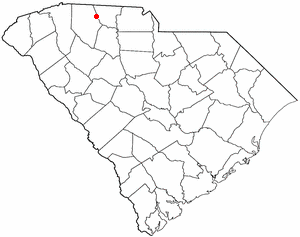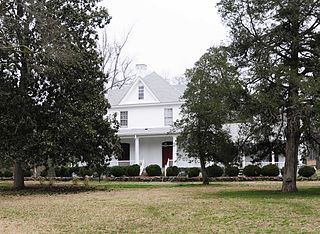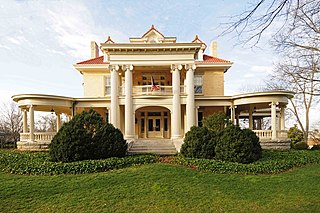
Cherokee County is a county in the U.S. state of South Carolina. As of the 2020 census, the population was 56,216. The county seat is Gaffney. The county was formed in 1897 from parts of York, Union, and Spartanburg counties. It was named for the Cherokee people who historically occupied this area prior to European encounter.

Gaffney is a city in and the seat of Cherokee County, South Carolina, United States, in the Upstate region of South Carolina. Gaffney is known as the "Peach Capital of South Carolina". The population was 12,539 at the 2010 census, with an estimated population of 12,609 in 2019. It is the principal city of the Gaffney, South Carolina, Micropolitan Statistical Area, which includes all of Cherokee County and which is further included in the greater Greenville-Spartanburg-Anderson, South Carolina Combined Statistical Area.

Cowpens is a town in Spartanburg County, South Carolina, United States. The population was 2,162 at the 2010 census. The town was chartered February 20, 1880, and was incorporated in 1900.

Inman is a city in Spartanburg County, South Carolina, United States, part of the Spartanburg metropolitan area. With a population of 3,665 at the 2020 census, Inman residents have access to nearby Lake Bowen that affords water recreational sports and fishing, and Inman is accessible by Interstate 26 and Interstate 85. The city contains a historic main street district, several houses of worship, and a school district.

Chesnee is a city in Spartanburg and Cherokee counties, in the U.S. state of South Carolina. The population was 868 as of the 2010 census.

Greer is a city in Greenville and Spartanburg counties in the U.S. state of South Carolina. As of the 2020 census, the population was 35,308, making it the 14th-most populous city in South Carolina. Greer is included in the Greenville-Anderson-Greer, SC Metropolitan Statistical Area, which is part of the Greenville-Spartanburg-Anderson, SC Combined Statistical Area in Upstate South Carolina.

Cowpens National Battlefield is a unit of the National Park Service just east of Chesnee, South Carolina, and near the state line with North Carolina. It preserves a major battlefield of the American Revolutionary War.

Cowpens Furnace Site (38CK73) is the remains of an early 19th-century iron-making furnace in Cherokee County, South Carolina. The site shows early American iron-making technology. The site was listed on the National Register of Historic Places in 1987.

The South Carolina School for the Deaf and the Blind is a school in unincorporated Spartanburg County, South Carolina, United States, near Spartanburg and with a Spartanburg postal address. It was founded in 1849 by the Reverend Newton Pinckney Walker as a private school for students who were deaf. The School for the Blind was established in 1855, and the school became state funded in 1856.

Southern Railway Passenger Depot, also known as Branchville Depot, is a historic train station located at Branchville, Orangeburg County, South Carolina. It was built in 1877 by the Southern Railway. It is a one-story, brick building with a stucco finish and hipped roof. It was the site of a speech given by President-elect William Howard Taft in 1909.

Pacolet Mill Office, also known as Pacolet Municipal Building and Town Hall, is a historic office building located at Pacolet, Spartanburg County, South Carolina. It built in 1908 by the Pacolet Manufacturing Company. It is a one-story, brick building with full-height basement level. It has a low-pitched hip roof with flared eaves and decorative exposed rafter tails. The roof is clad with clay Spanish tile. The site features a curving cast stone or concrete pergola added some time between 1920 and 1927. In 2004, the building became the town hall for the Town of Pacolet.

Evins-Bivings House, also known as the Dr. James Bivings House, is a historic home located at Spartanburg, Spartanburg County, South Carolina. It was built about 1854, and is a two-story, white clapboard house in the Greek Revival style. The house features double piazzas with massive Doric order columns and notable balustrades. Also on the property are the original kitchen, slave quarters, smokehouse, and well. It was built by Dr. James Bivings, who founded Glendale Mills.

Golightly-Dean House is a historic home located near Spartanburg, Spartanburg County, South Carolina. The oldest section dates before 1784. It is the one-story, double-pen, masonry wing. About 1830, the two-story, brick portion of the house was added. Following an 1884 tornado, further modifications were made to the dwelling. Located on the property are a contributing log smokehouse and a log shed.

Jammie Seay House is a historic home located at Spartanburg, Spartanburg County, South Carolina. It was built between 1770–1800, and is one-story, log house with a loft, field stone foundation piers, gabled roof, and an end field stone chimney. It has a one-story "L" rear addition and a one-story lean-to front porch. It was built by Jammie Seay, a Revolutionary War soldier of the Second Virginia Infantry. It is believed to be the oldest house within the present limits of Spartanburg.

Walter Scott Montgomery House is a historic home located at Spartanburg, Spartanburg County, South Carolina. It was designed by architect George Franklin Barber and built in 1909. It is a 2+1⁄2-story, frame, yellow brick-veneer residence in the Colonial Revival style. building is of frame construction with a yellow brick veneer and a red tile roof. It features a distinctive portico and leaded glass windows. Also on the property is a one-story, reinforced concrete auto garage.
Palmetto Theater was a historic movie theater located at Spartanburg, Spartanburg County, South Carolina. It was built in 1940–1941, and was a one-story, rectangular plan brick building. It featured a large marquee and a separate shop storefront decorated in blue Carrera-glass panels. The interior featured double balconies, Terrazzo flooring, large Art Deco light fixtures, decorative wall painting, and a plaster Art Deco screen surround.

Daniel Morgan Monument is a historic monument located at Spartanburg, Spartanburg County, South Carolina. The statue was designed by John Quincy Adams Ward and the monument erected in 1881. The monument commemorates the centennial of the victory at the Revolutionary War Battle of Cowpens and its hero, General Daniel Morgan. The statue stands on a columnar granite shaft on an octagonal base designed by noted Charleston architect, Edward Brickell White. In 1960, the monument was moved about 100 yards across Morgan Square to its east end. However, in 2005 as part of a larger project involving the redesign and reconstruction of Morgan Square, the monument was returned to its original position at the corner of West Main and Magnolia Streets and its original orientation, facing Cowpens National Battlefield.

New Hope Farm, also known as New Hope Post Office and Snoddy Farm, is a historic farm complex located at Wellford, Spartanburg County, South Carolina. The main house was built in 1885, and is a one-story farmhouse with Folk Victorian decorative elements. It features a steeply-pitched pressed metal-shingled roof, weatherboard siding, and a wraparound hip-roofed porch. Also on the property is a complex of domestic and agricultural outbuildings dating from about 1885 to 1905. They include a small two-story frame servant's house, a smokehouse, a privy, a corn crib, a buggy barn and a garage.

Frank Evans High School, also known as Evans Junior High School, is a historic high school building located at Spartanburg, Spartanburg County, South Carolina. It was built in 1922, with additions completed in 1925 and 1928. It is a three-story, Collegiate Gothic style, masonry school building. The school became a junior high school in 1959 when the new Spartanburg High School was built.

Pinckneyville is a historic frontier settlement site located near Union, Union County, South Carolina. Pinckneyville was established on February 19, 1791, by the General Assembly of South Carolina Act #1491 along with the Washington district, and is one of the earliest settlements in the South Carolina backcountry. Pinckneyville was named for Charles Cotesworth Pinckney. Pinckneyville was chosen because it was central to Union County, but Union was the seat of power.






















